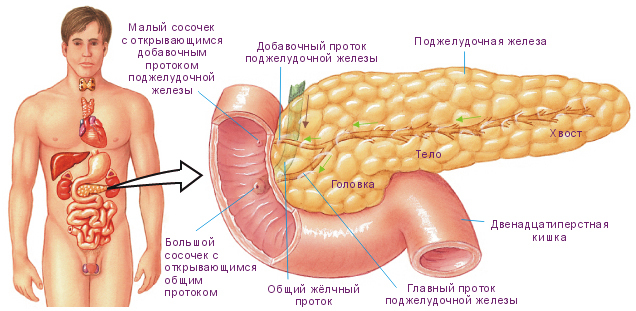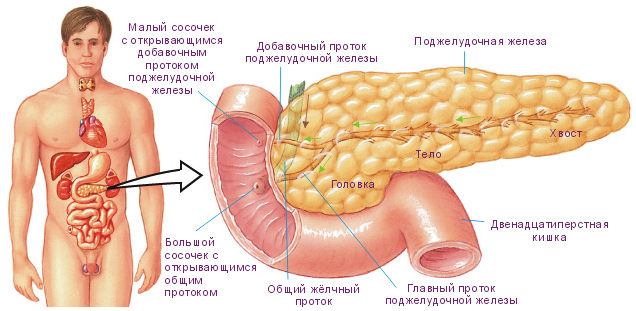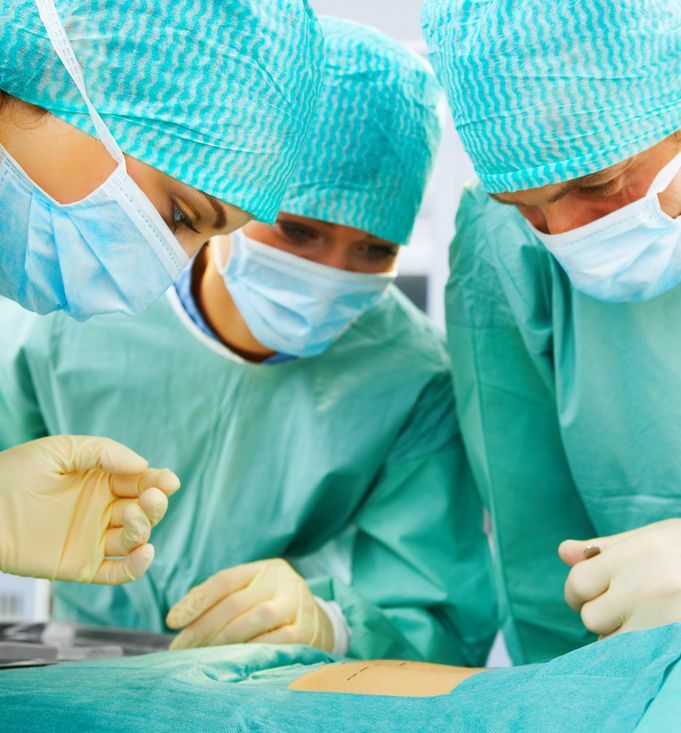The main symptoms of problems with the pancreas
Various symptoms of problems with the pancreas, which speak of changes in its functioning, appear in most people after eating disorders.
As a rule, the diet used for pancreatic pathologies is not observed by them. This body occupies an important place in the body.
It is necessary to notice symptoms and problems in time and contact the hospital so that the doctor can prescribe the treatment for stopping the disease as early as possible.
Pancreas: its purpose and structure
Contents:
- Pancreas: its purpose and structure
- Causes and symptoms of diseases
- Diagnosis of gland diseases
- Basic diseases affecting the pancreas
- Treatment system and dietary bases
The pancreas is called an intrasecretory organ belonging toTo the digestive system. It is located in the epigastric region under the left hypochondrium.
The body is divided into several parts: the head, body and tail.
There are several important functions performed by the pancreas:
- First, it participates in the digestion process. The digestive enzymes necessary for the cleavage of fats, proteins and carbohydrates( amylase, lipase, maltase, lactase, trypsin and others) are secreted by the pancreas through the duct to the duodenum;
- Secondly, releasing hormones into the blood stream( insulin, glucagon and others) affects carbohydrate metabolism. Because of the change in the work of individual sections of this body, diabetes mellitus develops.
Pancreatic pathologies affect many functions of the body: digestion and metabolism.
Symptoms of her diseases have the same symptoms in women and men. As a rule, this organ suffers from destructive and inflammatory processes.

The pancreas can suffer from a variety of diseases, the symptoms of which are almost identical.
Only the therapist or gastroenterologist can diagnose and prescribe the appropriate treatment by examining the results of the examinations.
A prerequisite for restoring the body is a diet, that is, proper nutrition.
Causes and symptoms of diseases
Pains in the epigastric region, at the location of the pancreas, indicate that some parts of the body do not cope with the functions.
These are signs that a chain development of abnormalities begins:
- ceases to excrete insulin;
- raises blood sugar;
- appears to be overweight;
- there is diabetes mellitus with complications( damage to the blood vessels).
This is how the disease develops with a diffuse change in the organ, unless the necessary treatment is prescribed. Reactive disorders are also harmful to the pancreas.
As a result of organ pathology, the inability of the intestine to absorb and absorb nutrients occurs.
The main causes of the development of pancreatic pathologies:
- is one of the main problems - this is an improper diet. Smoked, fried, fatty, carbohydrate-rich foods are contraindicated;
- alcohol is a poison for the pancreas;
- power supply at long intervals;
- consumption of large amounts of food;
- infectious diseases;
- clogging the duct with gallstone.
The main signs of pancreatic diseases are dyspeptic disorders and pain. Several diseases of this organ have the same symptoms.
From the digestive tract, vomiting, nausea, loose stools are observed. Severe pains of shingles appear in the hypochondrium.

They can be either permanent or periodic, given in the back or hand. If the patient's diet is wrong, the symptoms and problems are worse.
Cold compress and forced withdrawal can reduce pain:
- sit down and bend the body forward;
- lie on his side and pull his knees to his chest.
Often, in the pathology of the pancreas, digestion and assimilation of food is disrupted. Patients lose their appetite and weight.
Diagnosis of diseases of the gland
To understand the essence of the problem, the gastroenterologist will collect a detailed anamnesis, ask about what symptoms the patient noticed.
The doctor will perform a full examination and send the patient to perform the necessary tests. There are instrumental examinations( FGD, ultrasound, colonoscopy) and laboratory tests( biochemistry and general blood analysis, urine, feces and others).
Pain in organ pathologies is localized depending on which part of the organ is the pathology. If the head is broken, it hurts over the navel under the ribs on the right.
When the body of the gland is damaged, the pain is felt in the epigastric region, and the tail under the ribs to the left. If the pain is shingling, then the entire organ can be affected.
During the examination, the doctor must pay attention to the mucous membranes, skin, eyes and determine the disease to which the symptoms refer.
The doctor performs the palpation of the patient lying on his back, after that - on the left side. If the problems are associated with pancreatic dysfunction, then the pain on the side will decrease.
During the research in the laboratory, the doctor will be interested in the number of pancreatic enzymes: amylase, phospholipase, trypsin, elastase and others in the blood serum, general urine analysis and the presence of fat in the stool.
To determine the problems in carbohydrate metabolism, measure the amount of sugar in the blood. Before the delivery of the biomaterial, the patient should observe the diet for 3 days.
Survey radiography is one of the easiest ways to examine women and men. In the shadow image, a specialist can determine how much the organ is enlarged.
Video:
On angiography and CT, the pathology is also clearly visible.
The most common method of examination is ultrasound( ultrasound).
It can indicate the size, shape, localization, structure, thickness and condition of surrounding organs. Increased echogenicity indicates a disease that has arisen.
The main diseases affecting the pancreas
The pathology of this organ is many, but the symptoms may be similar. Despite this, in each case, a special treatment is required.
These health problems have a different degree of danger to life.
The most common pathologies include:
- chronic pancreatitis;
- acute pancreatitis;
- tumor formation.
Acute pancreatitis develops spontaneously.
It can be provoked by the following reasons:
- alcohol consumption( the amount does not matter);
- abundant fatty foods;
- gallstone stuck in the duct.
Because of these factors, the release of enzymes from the body practically ceases. Internal pressure in the pancreas increases, and a secret possessing high chemical activity digests living cells. Inflammation causes swelling, and bleeding is also possible.
The main symptom of the disease is a cutting and girdling pain, giving off to all parts of the abdomen. The patient is sick, vomiting can be repeated several times.
Blood pressure drops, and the pulse speed increases. The patient in this situation should be immediately hospitalized, so that he received the necessary treatment.
Chronic pancreatitis can be a complication of acute pancreatitis or develop independently for a long time.
Connective tissue gradually replaces normal in the process of development of pathology. The provoking factors in this disease are the same as in acute pancreatitis.
Video:
During periods of exacerbations that cause malnutrition, that is, the diet is disrupted, patients may experience painful pain. In many cases, the result of this pathology is diabetes, cancer or tissue necrosis.
Tumor formation is divided into cancer and hormonal. Symptoms for different problems differ.
Hormonal-active cells develop from specific cells that release a lot of hormones. This disrupts the work of all body systems.
Cancer formations are a complication of chronic diabetes, they have different signs and symptoms.
In all cases of development of the disease, competent treatment can be prescribed only by a specialist, and self-treatment is dangerous for health.
Treatment system and the basis of dietary nutrition
In order to normalize the pancreas and to avoid complications in a short time, it is necessary to begin treatment, during which the patient is recommended and diet.
One of the main ingredients in the therapy is diet or proper nutrition. Properly prescribed medications( enzymes, antispasmodics, NSAIDs) are also important.
To get a quick result during GI diseases in the treatment always includes diet and medications.
Video:
For diseases of the pancreas, diet No. 5 is prescribed.
Therefore, treatment with proper nutrition eliminates the following:
- fat;
- spices;
- fried, smoked dishes;
- alcohol;
- sweets in large quantities;
- rich broth;
- is extremely cold and hot food.
The diet permits:
- fish;
- lean meat;
- crackers;
- low-fat products;
- vegetable oils;
- fruits and vegetables, steamed.
When you go to the hospital, the doctor will be able to explain to the patient what foods the diet resolves in his particular case.


